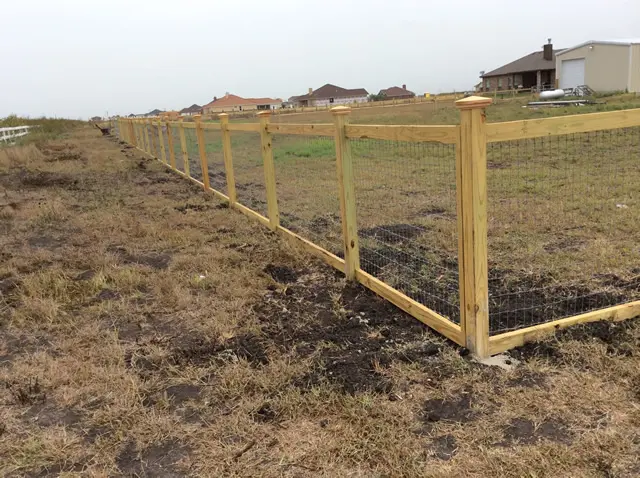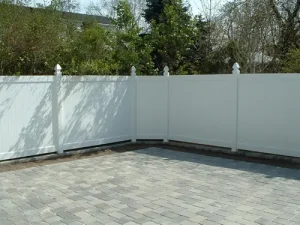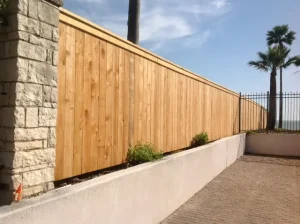![The Great Fence Debate Wood Versus Vinyl [How to Choose]](https://www.dcfence.com/wp-content/uploads/2024/04/The-Great-Fence-Debate-Wood-Versus-Vinyl-How-to-Choose-300x157.webp)
The Great Fence Debate: Wood Versus Vinyl [How to Choose?]
When it comes to enhancing the privacy, security, and aesthetic appeal of your home, few elements play as pivotal a role as your choice of

Maintaining a fence is essential to ensure it continues serving its purpose for years. Knowing how to repair your fence can save you time and money in the long run, whether it’s damaged by weather, age, or wear and tear.
We’ll walk you through some general fencing repair tips to help keep your fence sturdy, secure, and beautiful. We’ll cover everything from repairing fence panels and posts to fixing fence gates and hinges so you can confidently tackle any fencing repair project.
Before beginning any fencing repair project, it’s essential to assess the extent of the damage. Conducting a visual inspection of the fence is the first step in identifying any signs of damage, such as broken or missing panels, leaning posts, or damaged gates.
Once you’ve identified these issues, assessing the fence’s structural integrity is vital to determine the best course of action. By considering the damage thoroughly, you can ensure that your fence repair project is successful and that your fence remains sturdy and secure for years to come.
To repair your fence properly, you’ll need to have the right tools and materials on hand. Some essential tools for most fencing repair projects include a hammer, screwdriver, pliers, saw, and level. For different types of fencing, you may also require specialized tools, such as a post-hole digger or wire cutters.
In addition to tools, you’ll need various materials depending on the type of fence you have; for example, wood fences may require replacement panels, nails, and paint or stain, while vinyl fences may require replacement parts or adhesive. Having all the necessary tools and materials ready before beginning your repair project can save time and ensure that the job is done correctly.
If you notice that your fence is leaning or has loose or broken posts, it’s essential to address the issue promptly to prevent further damage. To identify loose or broken posts, walk along your fence line and check each post’s stability. If a post is wobbly, it must be secured with concrete or other materials.
However, if a post is broken, it must be removed and replaced. You can replace a broken post by cutting it out with a saw and digging a new hole for the replacement post. Once the latest post is in place, secure it with concrete and allow it to dry before reattaching any fencing panels.
When your fence panels have minor damage, like small cracks or holes, there’s often no need to replace the entire panel. Start by assessing the damage to determine what repairs are necessary. For small cracks or holes, you can easily fix them by using wood filler. Apply the filler to the damaged area, sand it until smooth, and then paint or stain the repaired section to match the rest of the fence.
However, if a panel is severely damaged and cannot be repaired, you must replace it completely. To do so, remove the damaged panel and attach the new one to the existing fence posts. This way, you can maintain the integrity of your fence while saving time and money.
Rot and decay can cause significant damage to your fence if left untreated. Signs of rot and decay include soft spots in the wood, discoloration, and a musty odor. To treat and prevent rot, start by identifying and addressing the source of moisture causing the problem.
Once you have addressed the moisture issue, use a wood preservative or sealer to protect the wood from further damage. If a section of your fence is severely rotted, you must replace it entirely to ensure your fence’s structural integrity.
Fence gates and latches can suffer from wear and tear over time, but they can last for years with proper maintenance. To diagnose gate and latch issues, check the hinges and alignment to see if they need to be adjusted or replaced. If the gate latch is not working correctly, inspect it to determine if it’s due to a worn or broken latch component.
Repairing a gate latch may involve tightening screws or replacing parts, and replacing a latch may require purchasing a new one that fits your fence gate properly.
Rust and corrosion can damage metal fences and affect their appearance. Detecting rust on a metal fence is easy- look for brown or orange spots along the surface. To remove rust, use a wire brush to scrub the affected area.
Then, apply a rust converter to transform any remaining rust into a protective coating. The metal surfaces should be painted with rust-resistant primer and paint to prevent further corrosion.
A sagging or leaning fence can compromise its effectiveness in providing security and privacy for your property. Recognizing the signs of a sagging or leaning fence, such as diagonal posts or noticeable dips, can help you address the issue promptly.
Strengthening fence supports by adding extra braces or reinforcing with concrete can help provide additional support for a sagging fence. If the fence is leaning due to loose soil, it may also be necessary to realign and stabilize it by adding soil and compacting it.
Wire fences are popular for keeping livestock contained and providing a barrier around the property. However, these fences also require maintenance and repair to keep them effective. One important aspect of repairing wire fences is checking the wire tension. Over time, wires can become loose and sag, compromising the fence’s security.
Additionally, patching or replacing any damaged wires before they break completely is important. Finally, strengthening the overall structure of the fence can help prevent future damage and ensure it can withstand any potential pressure from animals or weather.
Over time, weather and sun exposure can take a toll on even the most well-maintained wooden fences. The natural beauty of the wood may fade and discolor, leaving a lackluster appearance. However, before restoring your fence, it’s important to assess the extent of the weathering and discoloration.
From there, you can determine the best approach for cleaning and rejuvenating your fence–whether it’s power washing or a cleaning solution. Refinishing or repainting your fence may also be necessary, depending on the severity of the weathering.
Inspecting chain link fences for damage is essential to address any issues promptly and prevent further damage. Bent or broken links should be fixed or replaced, as they can compromise the fence’s integrity. In addition, if chain link fabric becomes detached or damaged, it may be necessary to reattach or replace it to ensure that the fence remains secure. Regularly inspecting and repairing your chain link fence can help to extend its lifespan and protect your property.
Troubleshooting electric fence issues is essential to identify any faults that may be present. Common problems include damaged or loose wires, faulty grounding, and issues with the charger. Replacing defective components such as chargers, insulators, or fuses can help to restore proper functionality. It’s important to test the fence regularly to ensure it works properly.
Enhancing fence security involves reinforcing the fence structure using durable materials and proper anchoring. Additional security features like barbed wire, electric fencing, and motion sensor alarms can be installed for protection. Securing gates and access points is crucial, and it can be achieved through robust locks, access control systems, and surveillance cameras to control and monitor entry and exit points effectively.
Regularly inspect your fence for signs of damage, such as loose boards, rust, or broken components, and promptly repair them to maintain their integrity. Applying a protective coating or sealant can prevent weather-related deterioration for long-lasting durability. Preventive measures like addressing rot, insect infestation, or soil erosion can help extend the lifespan of your fence.
Keep in mind that different fence types may require specific seasonal care. For example, clearing debris, adjusting tension for chain-link fences, or treating and staining wooden fences to shield them from moisture and sunlight damage.
When undertaking fencing repair, it is essential to prioritize safety considerations. Wearing appropriate safety gear, such as gloves, safety glasses, and sturdy footwear, can protect against potential injuries. When working with power tools for cutting or drilling, it is crucial to follow manufacturer instructions, ensure proper training, and use safety features like blade guards.
Additionally, precautions should be taken when handling chemicals, such as paint or sealants, by wearing protective clothing, working in well-ventilated areas, and following the recommended storage and disposal guidelines.
Consider professional fence repair services for complex or extensive damage, lack of tools or skills, or time constraints. When choosing a company, prioritize reputation, experience, and credentials.
Research customer reviews, seek recommendations, and verify licenses and insurance. Before hiring, ask relevant questions about expertise, timeline, cost, warranties, and specific concerns. These steps ensure you select a reliable professional for your fence repair needs.
A typical fence repair duration varies based on the damage extent, fence type, and material availability. Simple repairs may take a few hours, while complex ones span several days.
Whether to repair a fence or hire a professional depends on the complexity, skill level, and tools needed. Simple repairs can be DIY, but professionals should handle larger or more complex repairs.
Common mistakes to avoid during fence repairs include poor preparation, using incorrect materials, not addressing underlying causes, and neglecting safety precautions. Proper planning, using appropriate materials, addressing root causes, and prioritizing safety can help avoid these mistakes.
Regular fence inspection and maintenance are crucial for its upkeep. It is recommended to inspect the fence annually for damage and perform necessary maintenance tasks like cleaning, sealing, and painting. Factors like climate and fence type influence the frequency of maintenance.
Mastering general fencing repair is essential for maintaining a sturdy and beautiful fence. By following the tips and guidelines provided in this complete guide, you can confidently tackle repairs, enhance security, and extend the lifespan of your fence. Remember, don’t hesitate to contact D & C Fence Co. for professional fence repair services to ensure your fencing needs get taken care of efficiently.
By submitting, you agree to receive emails from Uscreen and to our privacy policy.
![The Great Fence Debate Wood Versus Vinyl [How to Choose]](https://www.dcfence.com/wp-content/uploads/2024/04/The-Great-Fence-Debate-Wood-Versus-Vinyl-How-to-Choose-300x157.webp)
When it comes to enhancing the privacy, security, and aesthetic appeal of your home, few elements play as pivotal a role as your choice of

PVC (Polyvinyl Chloride) fencing is a type of synthetic plastic fence that offers a modern alternative to traditional materials like wood and metal. Distinguished by

Wood fences are one of the most traditional and versatile types of fencing used to delineate property lines, enhance privacy, and contribute to the aesthetic
Complete the form below and a representative will contact you shortly.